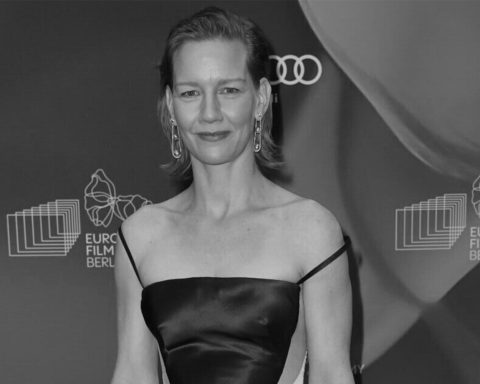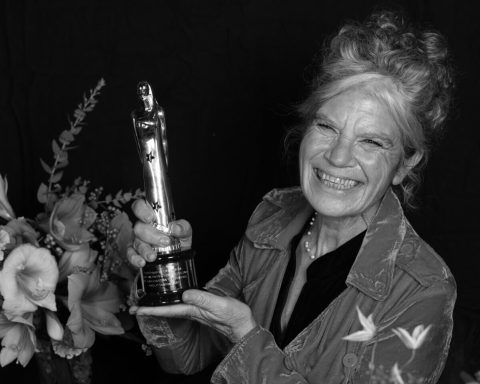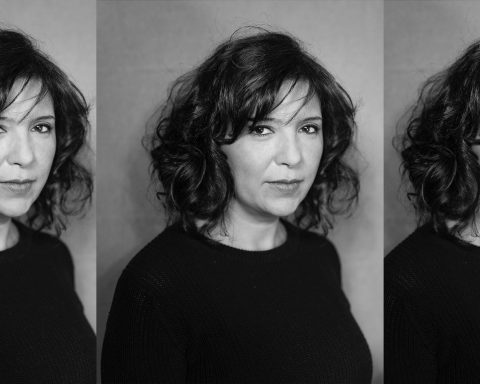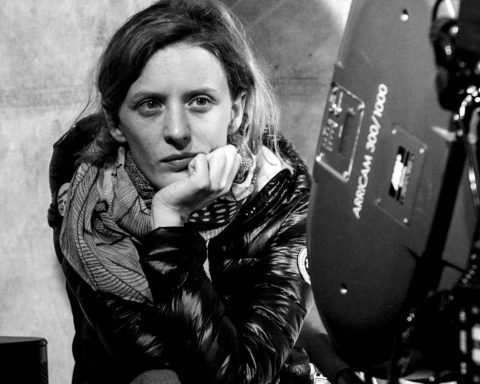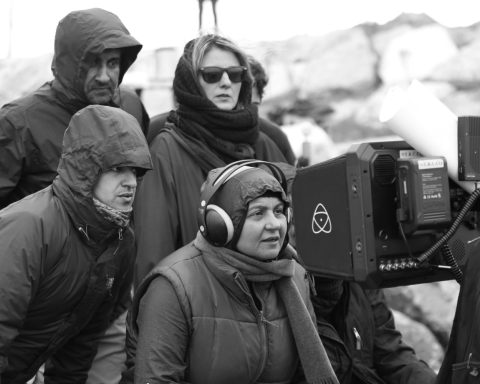Eva Vitija studied Screenwriting at the German Film and Television Academy Berlin (DFFB). She has written for cinema and television, including the screenplays for “Meier, Marilyn” by Stina Werenfels (2003), Anna Luif’s“Madly In Love” (2010) and “Little Paradise” by Paul Riniker (2010). Her first feature-length documentary “My Life as a Film” (2015) was nominated for the Swiss Film Award an a prize from the International Documentary Association in Los Angeles. The film garnered various awards, among which the Prix de Soleure.
Tara Karajica talks to Eva Vitija about feminism and film and her second feature documentary, “Loving Highsmith,” based on Patricia Highsmith’s personal writings and accounts of her family and lovers, and that casts new light on the famous thriller writer’s life and oeuvre, permeated by themes of love and its defining influence on identity. The film premiered at the 2022 Solothurn Film Festival and is now screening in the Europe! Voices of Women in Film program at this year’s Sydney Film Festival.
How did you get into filmmaking?
Eva Vitija: I first started writing screenplays, actually. Before I went to study Screenwriting in Berlin, I had written a few short films. Later on, I wrote many screenplays for television and fiction films. When I directed my first feature documentary, I just couldn’t let anybody else direct it, because it was a film about my father and how he was constantly filming my childhood. I am pretty sure I was opposed to the idea of becoming a director from the very beginning because my father filmed our family life constantly and was a film director as well.
How did Loving Highsmith come about?
E.V.: I had just made this film about my father and his filming private things – it’s called My Life as a Film – and was going home from the first festival premiere, where I had won an award. On the train, I thought: “I’ve made a film about an obsessive man (my father); now, I’d like to make a film about an obsessive woman.” Only days later, I stumbled upon Patricia Highsmith because someone showed me a list of names of authors. I pointed to Highsmith’s name and immediately I knew: “Maybe that’s her, this obsessive woman!” Then, I immediately started researching and realized that her entire estate and all her unpublished writings were in the Swiss Literary Archives in Bern. Only later, when I was already working on the film, did I remember that I had already “met” Patricia Highsmith as a child because my family sometimes went on vacation to Ticino, Switzerland, the place where Patricia Highsmith lived the last few years of her life. And, my parents told me that a famous American writer lived here, alone with her cats. I remember well how this had preoccupied me as a little girl: “Why does this woman live alone with her cats?”
The film depicts Patricia Highsmith’s byzantine and tormented life that was always filled with love and reveals a lesser-known side of the author – her exacting and essential search for love, for the physical and emotional intimacy with a partner. In that sense, love has always been the driving force and dominant leitmotif of her life and work even when she was forced to lead a double life and hide her relationships from the public and her family. Can you delve deeper into that and also comment on the title, “Loving Highsmith”?
E.V.: When I began deciphering Patricia Highsmith’s notebooks – they were hand-written – I first started chronologically, with her youth. And, it was immediately clear that, in addition to reflections on the writing itself, a very important leitmotif was love. I encountered in these very unfiltered notes a woman who was constantly falling in love, sky-high enthusiastic about other women. Love stories that often ended in great disappointment. And stories where, as she grew older, it became increasingly unclear how much of it actually took place in reality or only in her imagination. Patricia Highsmith was an author who had great sensitivity to everything that surrounded her. She had the perception of a lover who constantly sees signs everywhere and imagines all sorts of things in love, just as in writing, where one also imagines great worlds that do not exist. And, of course, all these stories were above all stories with women. For me, Patricia Highsmith’s private life is not interesting in itself. Nor is it any of our business. But it became so clear that many of her books and literary themes were steeped in it, and only drew from it, that this more private side of Highsmith became absolutely crucial to me for a film about her life and oeuvre.
The title expresses on the one hand that I myself and many readers have a great love for the author whose work is truly unique. On the other hand, the loving side of the author is brought into focus. For many, a surprising side, including me because before, I – and many others – had always thought: “This is simply a gloomy misanthrope with a penchant for amoral and abysmal crime fiction heroes.” And no one would have thought that there was also this deeply romantic side to her. That was what surprised me the most in the research. That’s why that became the focus of the film.
Patricia Highsmith became, over time, an icon of freedom and fight against the discrimination inflicted by a bigoted and stifling society that viewed diversity as a perilous abnormality and not the creative power it was or could be. Highsmith was a woman and a writer who challenged convention within a patriarchal and heteronormative society that only saw women as wives and mothers, docile and pliant. Indeed, Highsmith has never adhered to any binary gender role, her identity has always been intentionally ambiguous, vague, fluid, ever so changing and evolving. In that sense, Loving Highsmith is a poignant tribute to love between women, to lesbian identity and to the battles fought by those who have been discriminated against by an intransigent and narrow-minded society. Can you elaborate on that?
E.V.: It’s interesting that Highsmith lived a life that couldn’t have been more feminist, but always said that she didn’t have much to do with feminism. Even though she lived a very independent and self-determined life, her image of women was still that of her time. She saw them as dependent on men, passive and tied to their home and family. And, because she rejected that herself completely and in no way wanted to live that way, she identified more with men. She was always financially independent, and that was very important to her. She traveled as much as she wanted. She ran riot sexually. Everything that was typically attributed to men in her youth. There is a significant passage in an essay about her childhood, A Try at Freedom, where she describes that once at school she looked out of the window and below a traveling salesman was rushing by. The moment she saw him, she knew she wanted to be like that. As free as this salesman. To be able to decide for yourself where to go and what to do, not being held accountable to anyone. And, maybe even eat an apple cake just because you want to… Many of the characters in her novels are men, probably because of that. But, in the short stories, there are also many female characters.
Loving Highsmith is based on documents from the Swiss Literary Archive which help reconstruct the writer’s complex universe along with unseen photos and touching testimonials from those who knew and loved the author. Can you talk about the research and reconstruction/filming processes? What did you learn during the research and while making the film?
E.V.: When I started researching Loving Highsmith, I read her notebooks pretty much at the beginning. Well, “read” – I deciphered her rather illegible handwriting, sentence by sentence. And, the impression of this research gave me the motivation to make a film about Patricia Highsmith in the first place because I was so surprised by the person I encountered in these notebooks, in these unfiltered thoughts, impressions. I really wanted to know why the public image of Highsmith and these notes were so divergent. I excerpted, with an assistant, about three hundred pages from eight thousand pages of unpublished notebooks, diaries, manuscripts, and letters. This later became a collection of quotations for the film, perhaps thirty pages long. This condensation was a long process in editing and before it. To get a handle on the material, I keyworded the quotes by subject and categories, like books in a library. But working with Highsmith’s unpublished texts was the most exciting thing of all for me. Of course, text doesn’t make a movie. At the same time, I visited the family and that was ultimately the starting point for the visual layer of the film: they still had some boxes of material by Patricia Highsmith and let me look through this material. Among them were many wonderful photos from her childhood and youth. Later, of course, I got more material from all sorts of other sources. The family also had film material. Unfortunately, not 16mm family films as I had hoped, but films from Rodeo. For the television archive materials, we combed through all the television archives throughout Europe and the U.S., which was also a taxing process. Then, in editing, with editor Rebecca Trösch, we tried to find ways to create images for the texts without simply illustrating them. Rather, we wanted to find a kind of dialogue between texts, images and music.
How did Gwendoline Christie join the film? Can you talk about working with her on this particular project?
E.V.: First of all, I just listened to the voices of a lot of English and American actresses. And, when I came across Gwendoline Christie’s voice, there was something about it that reminded me of Patricia Highsmith’s voice. An openness and fragility that other voices didn’t have. And, at the same time, they’re both very engaging voices. It wasn’t until after that that I looked up the actress’s name, and realized how well-known she is for her roles of Brienne of Tarth in Game of Thrones and Miranda Hilmarson in Top of the Lake by Jane Campion. The fact that she also plays with gender fluidity in her choice of roles and interviews was, of course, extremely convenient for us for the embodiment of Patricia Highsmith. And, we were incredibly lucky that she was involved, even though this was just a small Swiss documentary. But she knew and loved Patricia Highsmith and had even met her one biographer who was a friend of her mentor’s, Simon Callow.
It was a huge pleasure to work with her. The two days with her in the studio in Bucharest, where she was shooting a series for Tim Burton, were a dream come true for me! She had prepared very well with her language coach. When she came in, she sounded just like Highsmith. We then worked on her sounding more like herself again and there was a development in the voice through the film. She was very open to my input and understood exactly what I wanted. Through the voice, she had learned a lot about Highsmith in a very short time. It was fascinating and a great pleasure!
What were the challenges you encountered when making this film?
E.V.: It was not easy to find Patricia Highsmith’s ex-girlfriends. It is a generation that has basically left few traces on the Internet. So, you first have to know where they live, etc. I didn’t even know their current or real names in some cases because they had been anonymized in the biographies or had married later on. It was sometimes real detective work to track them down. And, of course, convincing them to be in the film, even though they’d spent their whole lives keeping their private lives – and most certainly their love lives – under wraps. And then, of course, it wasn’t easy to acquire all the rights, from the big Hollywood adaptations to the text rights to the almost hundred-year-old photos, where you sometimes had to do painstaking research to find out who the photographer or his/her heirs could be in order to acquire the rights.
Are you a feminist? If so, how does this inform your filmmaking?
E.V.: I am certainly a feminist, if you define feminism in such a way that it is absolutely self-evident to me that women should have the same rights as men and that one should generally question the social gender roles. In film, feminism is absolutely crucial for me. There are so many films where the male gaze is celebrated and women – and men – are portrayed very stereotypically. I sometimes almost can’t stand such films as a woman. I really like good action movies, for example. But when it’s always just about a Mack who has to free the poor, raped and tied up sexy woman, it turns me off completely. As a filmmaker, of course, I’m into completely different genres. With this film, it was simply great to see how many super interesting older women there are with a great sense of humor, looking back on a great life. And Highsmith, of course, offers particularly attractive material, because she herself has always resisted classic images of women in her life.
What subjects interest you and that you would like to tackle in your work? What would you like audiences to come away with after watching your films?
E.V.: I am interested in many topics. At the moment, I’m thinking about making a film about photo agencies, because I think it’s a scandal that many of our historical photographs have been bought by huge corporate agencies in recent years and are thus no longer available to the public. On the other hand, I would like to make a film about the connection between fat and sex because I think women struggle all their lives with certain expectations about their bodies, and the reality on the surface is again very different from the issues behind it. Maybe that’s what interests me in general. To scratch the surface of our images and try to discover what’s behind them. I’m satisfied if the audience recognizes themselves in my films and can connect with them, and are entertained on the one hand, but can also reflect on their own lives on the other.
Who is your favorite female filmmaker and what is your favorite film by a female filmmaker?
E.V.: Maybe Jane Campion and Agnès Varda. I especially liked An Angel at my Table and Vagabond.
There has been a lot of talk about the situation of women in the film industry these past four years. What is your take on the matter? How is it in Switzerland?
E.V.: The film industry is not particularly different from other industries in terms of discrimination against women. The special thing about the film industry was perhaps that many thought: “We filmmakers are so progressive, we don’t have a problem with discrimination.” But it’s only now that the statistics are giving us the naked truth. In Switzerland, female filmmakers are still paid much less than their male counterparts. And, the networks through which jobs are given have long been very male-dominated. It seems as though something is happening now. The funding agencies in particular are sensitized. They now want to promote women more in order to achieve equality.
What are you working on next?
E.V.: The ideas I am working on are still at the very beginning. Two I have already mentioned, another would be again the biography of an exciting woman. I definitely have more desire to do something about women or women’s issues again. There are already so many films about men. That’s the only thing that’s clear. But we’ll see which of the ideas remains in the end and is so exciting that I feel like delving into it for several years.
Photo credits: ©Martin Guggisberg.
This interview was conducted in partnership with:

and







